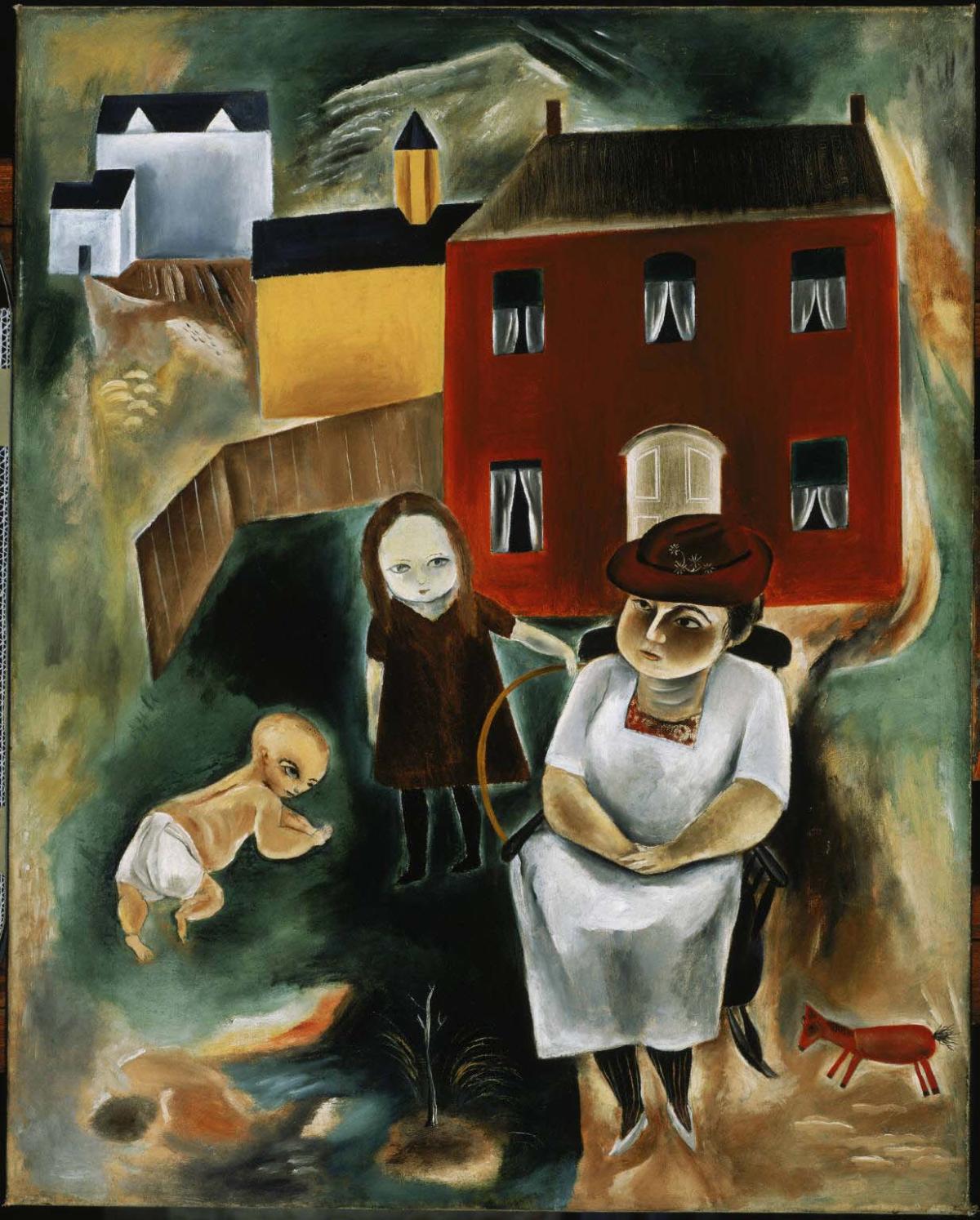Maine Family
Yasuo Kuniyoshi ( c. 1922-c. 1923 )

Yasuo Kuniyoshi emigrated from Japan to America in 1906.[1] He was mentored by Hamilton Easter Field (1873–1922), a proponent of developing American modernism out of folk and Indigenous traditions as opposed to European influences. Kuniyoshi became a collector of American folk art and summered at Field’s artist colony in Ogunquit, Maine.[2] In Japan, the Mingei movement, led by Yanagi Sōetsu (1889–1961), was rising in popularity. Mingei placed value on traditional crafts, and thus the importance of heritage was elevated. These dual influences came to define Kuniyoshi in the eyes of art critics at home and abroad, but the artist rejected this interpretation, seeing himself as an American artist and a foreigner in Japan.[3]
Maine Family is characteristic of the duality of whimsy and gruesomeness in Kuniyoshi’s work. The viewer encounters distorted, indistinct forms in the landscape and sickly colors marred by dark shadows. Yet the subjects look at each other with affection. The familiar and the frightening are countering themes that speak to the two Kuniyoshis: the proud American who was accepted and admired by his fellow artists, and the Japanese immigrant in a 1920s America fraught with xenophobia in the wake of World War I. The figures, the rocking chair on which the woman sits, and the colonial-style houses that appear in many of Kuniyoshi’s landscapes offer typical American scenery. Childhood, as represented by the baby, the girl with a hoop, the toy horse, and the sprouting plant, plays an important role in Kuniyoshi’s work. Childhood and folk art iconography allowed Kuniyoshi to explore nostalgia for the past and create an analogy for the exploration of the development of American art and culture.
Maine Family was completed a year before the passage of the Immigrant Act of 1924 (the Johnson-Reed Act). In 1941, following the attack on Pearl Harbor, Japanese Americans, including Kuniyoshi, were deemed “alien enemies.” His camera and other items were confiscated and his accounts were frozen by the US government. Kuniyoshi recounted that where he once felt comfortable he now noticed people staring at him warily. For all his success, Kuniyoshi’s last years and legacy were overshadowed by America’s hostility to immigrants.[4]
Text by Rebecca Shipman as part of the Seeing U.S. Research Project
[1] Susan Stamberg, “The Anxious Art of Japanese Painter (and Enemy Alien) Yasuo Kuniyoshi,” aired August 13, 2015, on NPR.
[2] Gail Levin, “Between Two Worlds: Folk Culture, Identity, and the American Art of Yasuo Kuniyoshi,” Archives of American Art Journal 43, no. 3/4 (2003): 2–17.
[3] Tom Wolf, The Artistic Journey of Yasuo Kuniyoshi (Washington, DC: Smithsonian American Art Museum, 2015).
[4] Stamberg, “Anxious Art.”
Yasuo Kuniyoshi painted Maine Family during one of the summers he spent at an artists’ colony in Ogunquit, Maine, in the 1920s. An early work, it reflects the simultaneous influences of both the Western modernist idioms and his Japanese artistic heritage. Its distortions of scale and perspective resemble a child's depiction of family members in front of their house. However, the curious omission of a man from the group, along with the juxtaposition of the formally attired lady, the diaper-clad baby, and the otherworldly quality of the little girl, which is likely inspired by memory portraits in nineteenth-century American folk art, add to the unconventional air. Certainly the folk art influence, as well as naive styles in modern painting, like those of Henri Rousseau, Marc Chagall, and Heinrich Campendonk, can be detected in Kuniyoshi's handling of the composition and details in Maine Family.
Simplified rectangles and triangles of color define the background buildings and reflect the artist’s exposure to Cubist painting. In contrast, the figures, which are angular and possess Kuniyoshi’s characteristic almond-shaped eyes and unnaturally pointed feet, are given bodies that exist as three-dimensional entities in space.
In 1928, twelve years before Duncan Phillips acquired Maine Family, his first work by the artist, he recognized Kuniyoshi as a serious painter who beautifully combined Japanese and American artistic tendencies. He admired the artist's "confident calligraphy . . . stylistic brush writing . . . [and] arbitrary color chord of ivory and ebony and lacquer red," which appeared throughout Kuniyoshi's oeuvre, as well as the "plasticity" and "vital" evocation of "the inner truth" that Phillips believed he had acquired from Western art. To Phillips, Kuniyoshi's painting represented a "new idiom of quaint pictorial expression."